SEO optimization and how to do it with Mozello

SEO, short for search engine optimization, is the process of making a website appear as high as possible in search results on Google and other search engines. Why is it so important? Because you want people to find your website when they search for keywords related to your business.
Simply put, SEO is a way of telling Google: ‘Hey! If people search for X, please show my website in the search results!’ You can achieve this by strategically placing keywords relevant to your business in key sections of your website. This article will show you exactly where to do it and how.
SEO can help your business:
- Become visible and findable
- Attract high-quality visitors to your website or online shop
- Build brand trust
- Offer a better user experience
- Save money on paid advertising
In this simple and practical tutorial, we’ll look at how to get the most out of Mozello’s SEO features.
Tip 1. Add effective title and meta description tags
TITLE tags and META description tags are a part of the website that usually appears in search results:
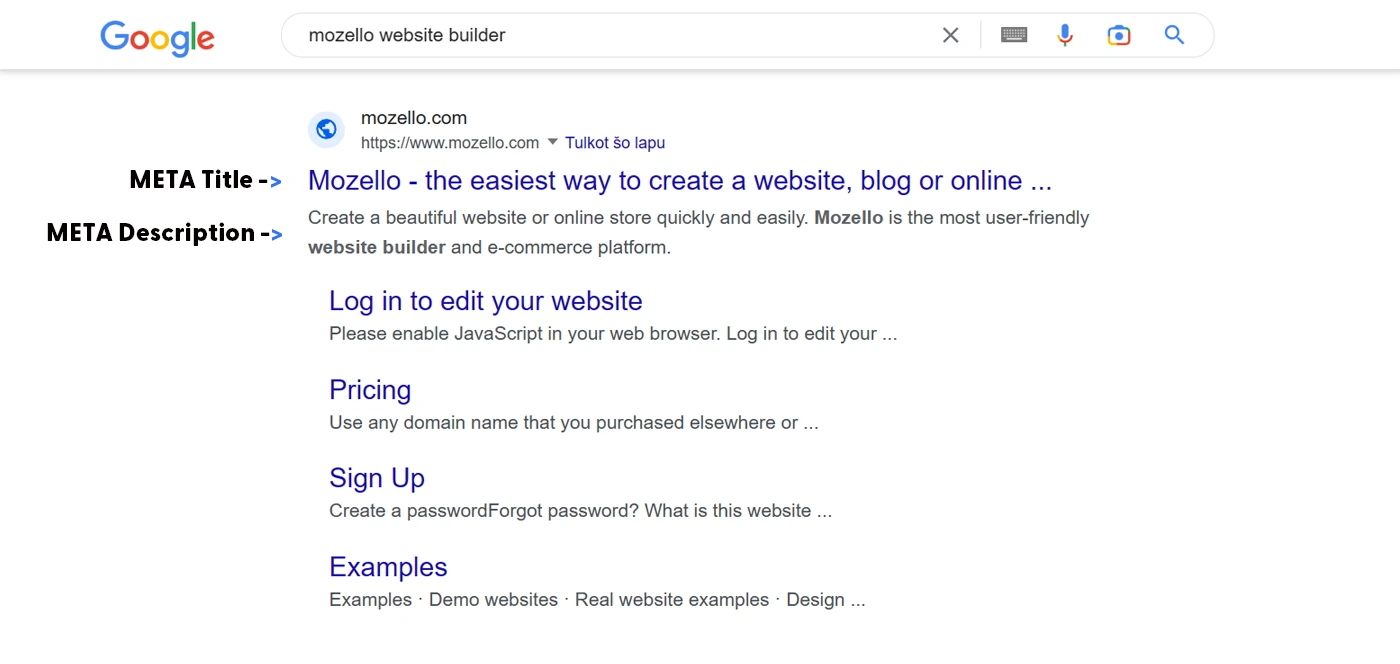
On your Mozello page, you can find the meta fields of a page by going to Pages → selecting the page you want to edit → clicking Advanced Settings.
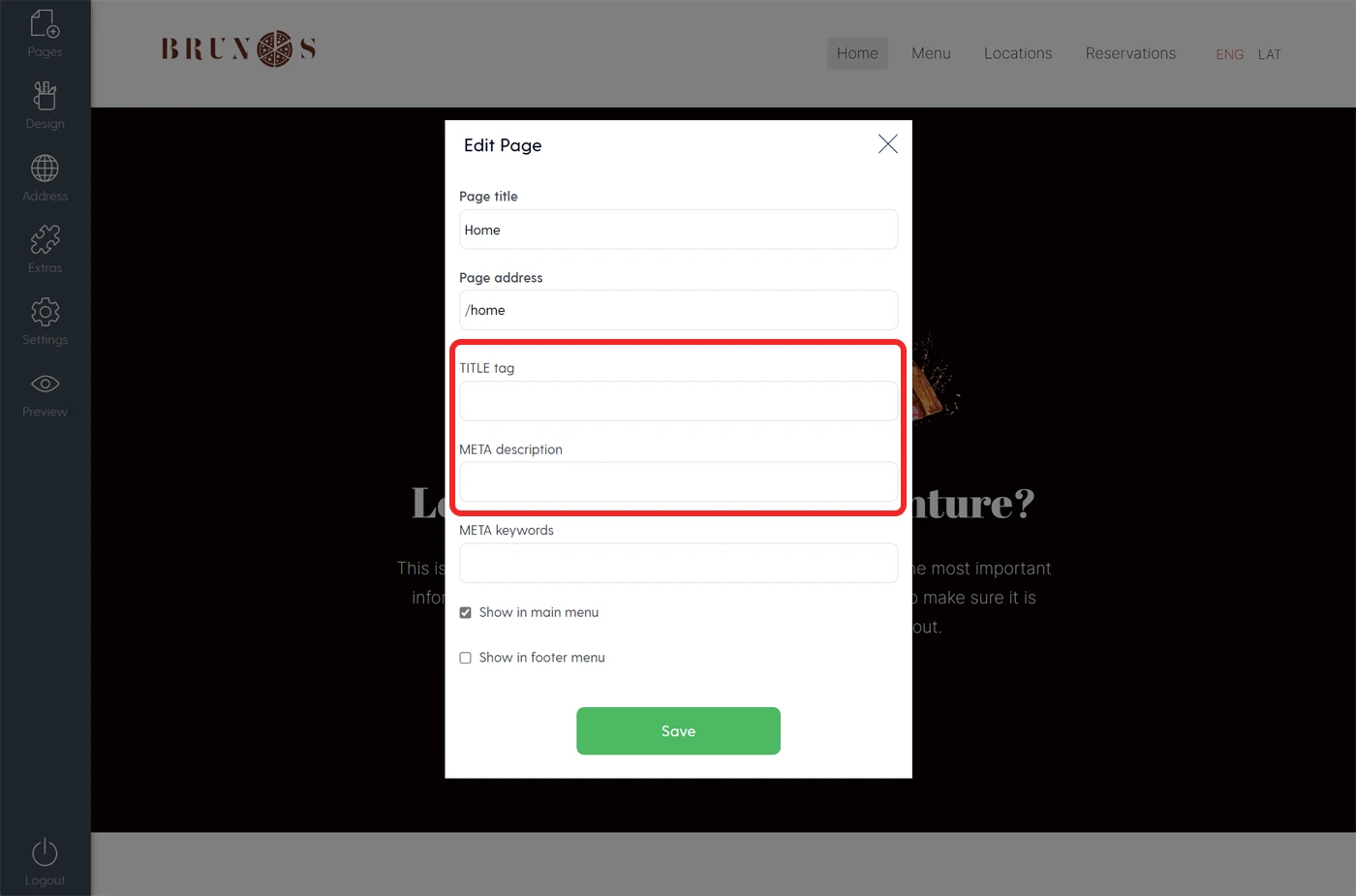
We recommend that you create attractive, custom title and meta description tags for all your pages, as this will help your page rank higher in search results and attract more guests.
Tips for choosing good title tags:
- Important: include the most important keywords that people will use to find this page, e.g. ‘[restaurant] menu’
- Try to keep the title tag length within 60 characters. Google shortens longer tags
- If possible, include your brand name: this creates visibility
- Create intriguing title tags that people will want to click on
- Example: Bruno’s Pizza menu: order a delicious pizza now
Tips for good meta descriptions:
- Important: create inviting descriptions that people will want to click on
- Include the most important keywords that people will use to find this page, e.g. ‘[restaurant] menu’
- Try to keep title tag length to 160 characters. Google shortens longer tags.
- If possible, include your brand name: this creates visibility
- Example: We’ve got exactly what you want. Check out Bruno’s Pizza menu! Get our delicious pizzas: meat, vegan, or seafood.
Tip 2. Create meaningful website page URLs
In the same place, you can also find a Page address field.
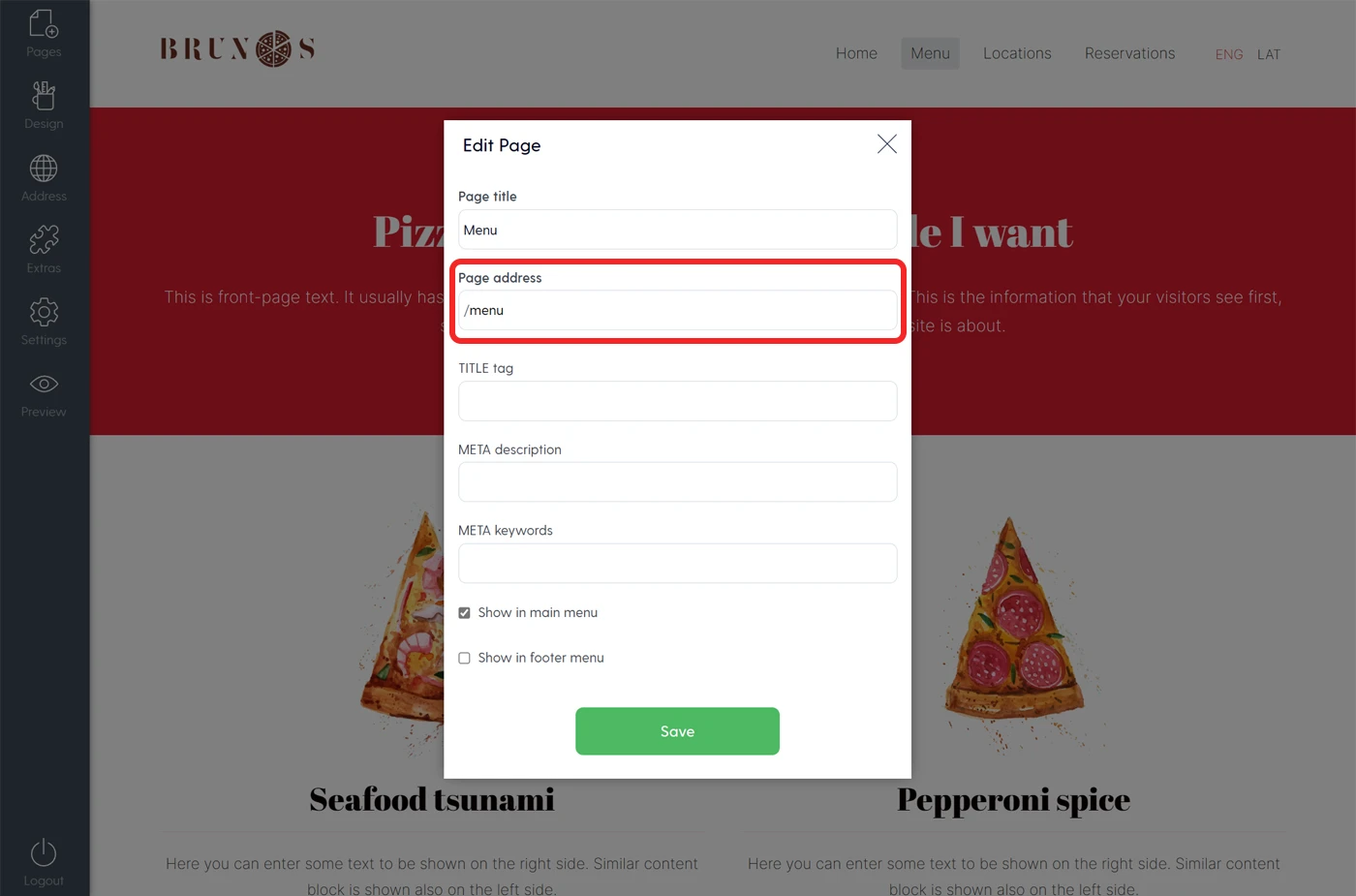
The page address is what will appear in the URL bar when users switch between different pages of your website, for example: brunospizza.com/our-menu/pizza-margherita.
Putting the keyword in the page address helps in two ways:
- It boosts SEO by making it easier for search engines to navigate your page and better understand its structure
- This will make navigating the site easier and more transparent for its guests
In our example of a pizzeria menu page, the ideal address would be /pizzeria-menu. If you are a plumber and want to offer your services, /plumbing-services or something like that might be a good approach.
Important: choose the page address once the website is created and never change it again, because changing the address of an existing page of your website invalidates the old address wherever it appears and also harms the ranking of that page.
Tip 3. Use keywords in the content of your website
The goal of the search engine is to display the most relevant results for your search. So, if someone searches for ‘best pizza in London’, and you haven’t included these words on your page, the search engine is unlikely to find your website.
It is important to make sure that you include the keywords you want your website to be found for in each section of your website. These keywords should be used in the titles, descriptions, and body text wherever possible.
Example:

Someone initially posted the following text on their website:
- Raise the company standards
- Reach new heights with our services and software
And no one is likely to search for the keywords used in the original text. People look for much simpler phrases, like ‘how to grow your business’, ‘how to improve business results’ or ‘software for business’, so it is important to include these keywords in the text.
Note: resist the urge to overdo it and stuff every sentence full keywords. Google will see you trying to fool it and will rank your page lower or remove it from the results as a penalty. Try to mention the most important keywords 2–3 times on each page so that the text sounds natural, and don’t be afraid to use different language forms of these words and phrases, because the search engine mostly understands them, as well as synonyms.
Tip 4. Use headings and formatting
Google likes websites to be well structured and gives extra SEO points for this. Why? Because well-structured websites are easier to read for both humans and search engines.
But what does a well-structured website really mean? Mainly that you use headings and formatting to distinguish different bits of content on each page.

Formatting options show up when you click on a text field on your page.
Format each page by setting the appropriate text type: if it is the main heading, use Heading 1. If it is a subheading, choose Heading 2, etc. If it is a simple paragraph of text, use Body Paragraph etc. Don’t forget to follow this approach in your blog posts and other content!
Content creators often simply increase the size and change the style of the text to create headlines, but this is a mistake because it doesn’t improve the rating of your website: Google will see it as one huge block of text. The heading formatting features that the system offers not only visually enlarge the text, but also lets the person search know that it is a heading and how important it is. Heading 1 is the big heading and is therefore the most important of the heading types. Heading 2 and 3 are subheadings and should, therefore, be used as appropriate and necessary.
Important: try including a few key keywords in your headlines, but don’t stuff all your headlines full of keywords, because this can lead to penalties for excessive optimization. Headlines must be relevant to the topic and easy to read.
Tip 5. Create meaningful alt text for your images
When you upload an image to your website, click on it to open the toolbar. Then, click on Image Properties (the spanner icon) to open the settings, where you’ll find the Image title (alt text) box:
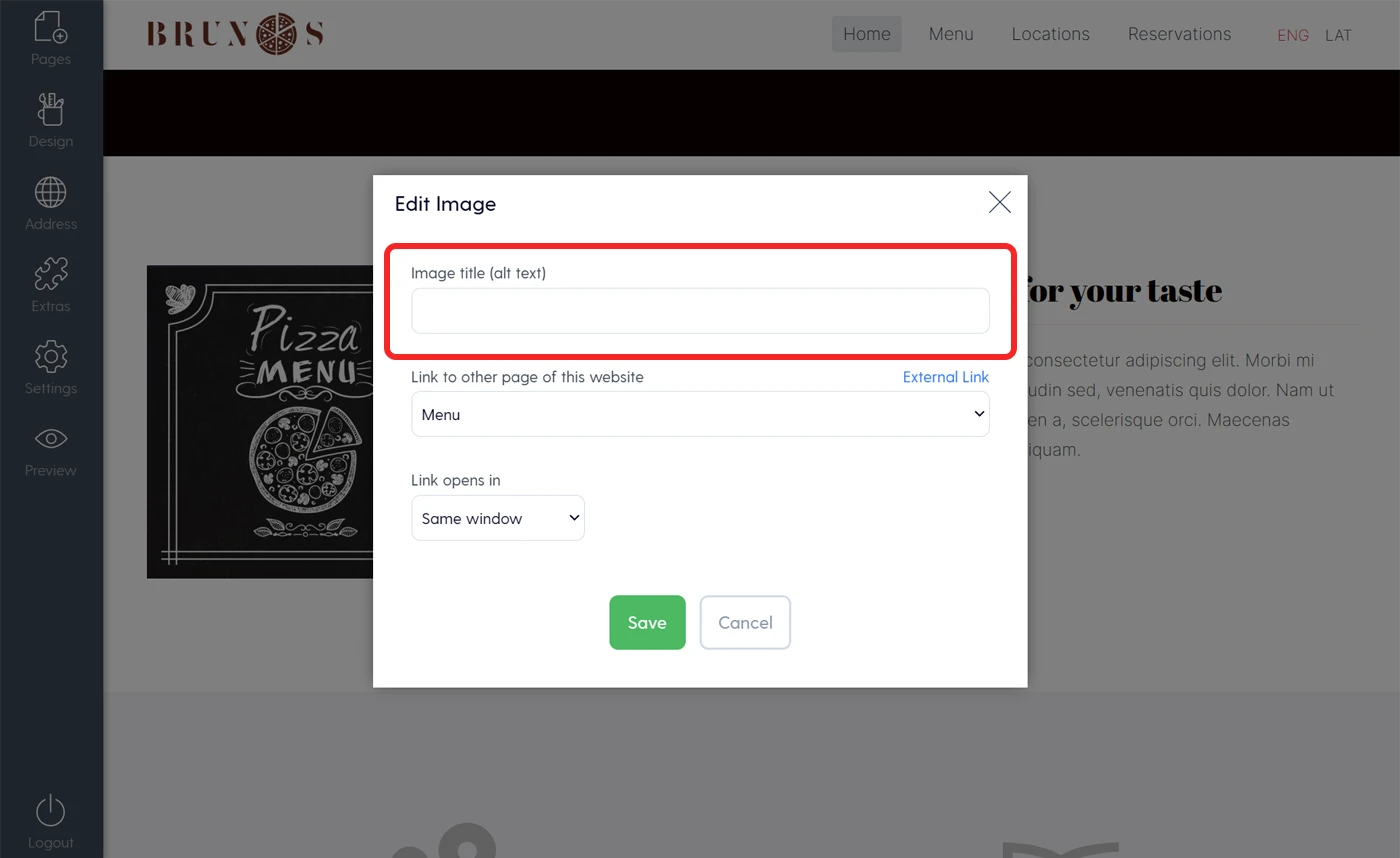
The alt text of an image is a description that appears instead of the image if, for example, it fails to load. But this is not its only purpose. For example, for visually impaired guests who use text-to-speech, alt text helps them explain the meaning of the image.
It also explains the content of the text to Google, helping you gain SEO points in two ways:
- If you add alt text, you provide a better user experience, and Google appreciates it.
- If you add keywords to your alt text, you are telling Google that there is relevant visual material on this page.
The alt text of the image should be a brief description of what’s in the image, e.g. in the case of a pizzeria menu, a good alt text could be ‘pizzeria menu written on a blackboard’ — a detailed, informative description that has the main keywords.
Tip 6. Online store categories and product links that make sense
This is for those who sell their products online with Mozello: the process is similar to the page addresses we mentioned above.
Note: Mozello currently automatically tries to generate SEO-friendly links for all new online store categories and products using the category or product name.
However, if you have an older page that needs optimization, go to the Storeue management, move your mouse to the category you want to edit and click on the pencil icon:
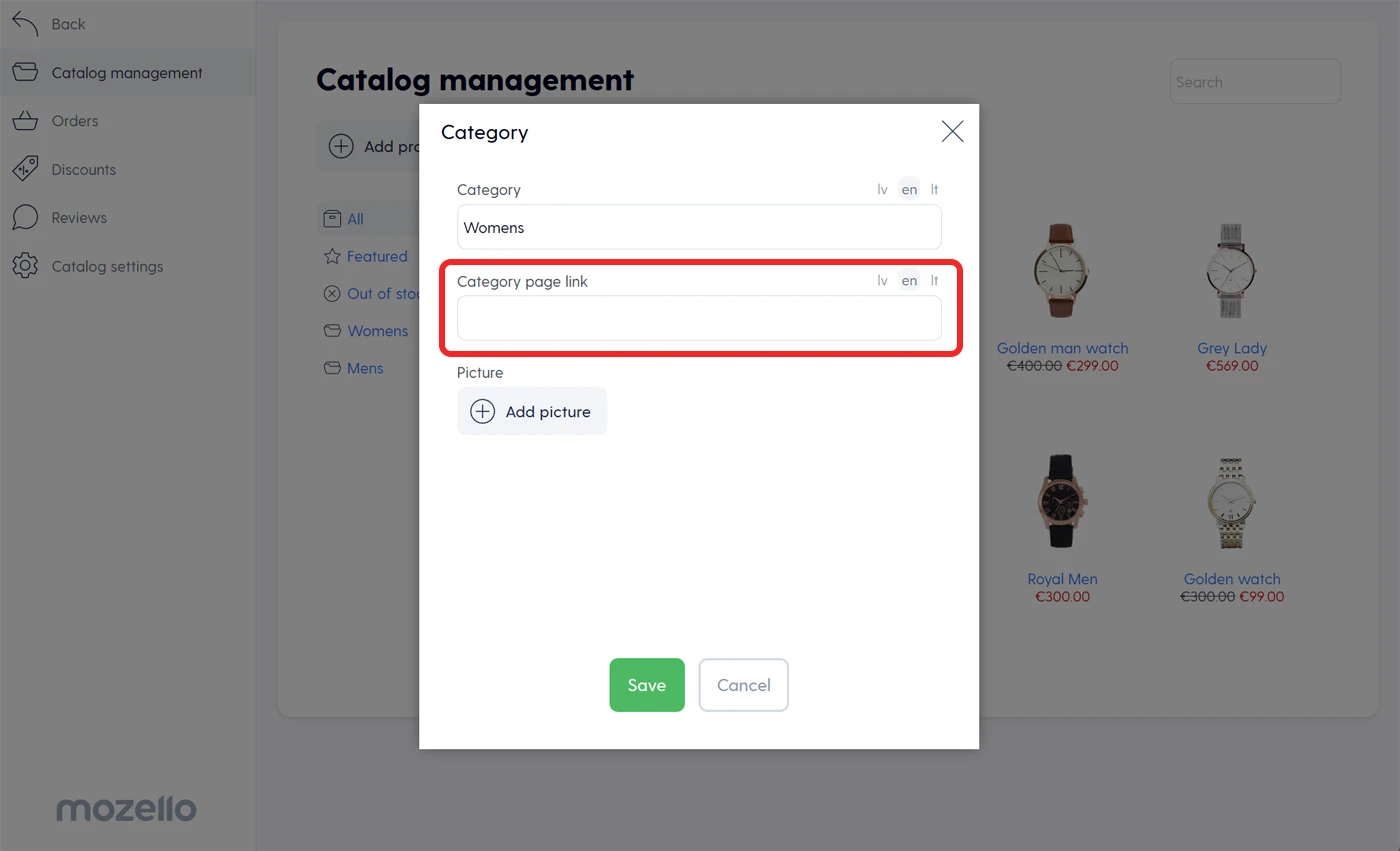
Now all you have to do is think of an appropriate name for the category link. In our example, we have a ‘women’s’ wristwatch category in a watch shop, and a good category link could be ‘women-wristwatch’.
The same can be done for individual products by going to the product page, selecting Advanced settings and scrolling down to the Product page link field.
As we’ve mentioned, SEO-friendly page links are now automatically created when you add new products, so you won’t have to worry about it unless you want to customise something in particular.
Tip 7. Boost SEO by writing a blog
Another activity that helps improve SEO rankings is blogging. The magic of a blog is that it adds to the content of your website, which in turn increases the number of keywords that Google uses to find your company.
For example, if you own a plumbing business, it’s a good idea to publish a few DIY articles, such as ‘How to fix a leaking tap’ or ‘How to clear pipes with tools you have at home’.
This way, you not only attract people who need a plumber, but also those who would like to handle the task themselves. And... chances are, they’ll fail to do it on their own sooner or later: something will inevitably go wrong, the right tools won’t be available or something else will happen, and by then, they will have seen your website where you offer to solve all their problems.
In other words, by writing a blog, you provide another way for potential clients to discover your business and the services you offer. By creating quality content, you can improve your company’s credibility and expand your client base.
Don’t forget to use the same SEO strategies in your blog as you did for your website: add keywords, format your content, write alt text for your images. In this guide, we’ve talked more about why it’s important to blog, how to get started, how to come up with topics and how to blog effectively.
Tip 8. Off-site SEO
Everything we’ve discussed so far is about on-site SEO, i.e. the work that needs to be done on your Mozello website to improve its ranking in search engine results. But that’s only half the job.
To end this guide, we’ll also briefly touch on off-site SEO: things that also help your SEO rankings, but happen outside your website.
The most important off-site optimization approach isbacklinking to your page. In short, Google looks at how many links from other websites, and of what quality, lead to your website in order to rank it. Simply put, the more other websites link to yours, the more credible your website looks to Google and other search engines, and the higher it will appear in their search results. And the more popular the website that publishes your link is, the greater this effect. Meanwhile, links from little-known and unpopular resources will have a minimal SEO effect.
These links can be created in a variety of ways: by guest-posting on other websites, setting up partnerships, etc. Your main goal is to get other websites to link to your website.
For example, if we want to have links leading to our pizzeria elsewhere on the internet, we can collaborate with a food blogger, say, offering one of our special secret recipes in exchange for the blogger including a link to our website in their article.
These off-site links are very important for growing natural visitor traffic, but before you do that, make sure you’ve taken care of all the on-site SEO work that needs to be done on the website itself!
Finally, a to-do list
Basic tasks to do to improve your website’s SEO:
- Add title and meta description tags to all pages of your website or online store
- For new pages, create good URLs
- Include the right keywords across the website
- Format your content
- Update the alt text of your images
- If necessary, revise your online store category and product links
If you want to further improve your page’s SEO rankings:
- Create a blog
- Off-site SEO
Once you’re done with all of the above, you can be sure that you have a strong SEO foundation that will help attract traffic to your website and help your business grow.
If you have any questions or need help, feel free to reach out to Mozello Customer Service.
